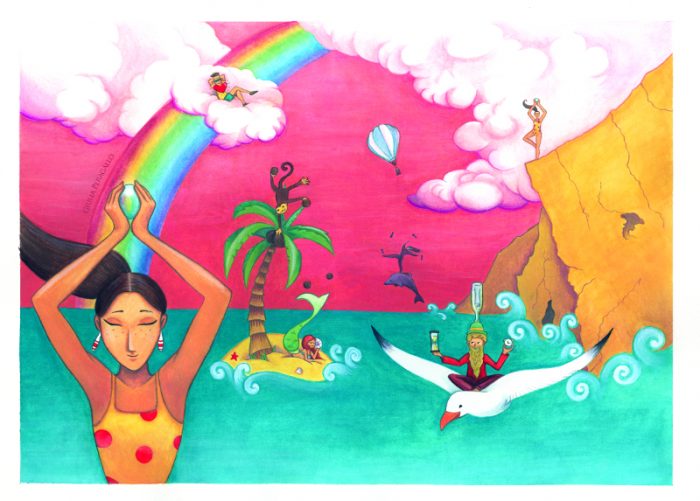

https://www.instagram.com/p/BNOV_ZaAzd4
Juggling: A meditative practice.
Many jugglers, especially in the beginning, fall into an almost meditative state when training, where time and tiredness no longer exist – you could find yourself juggling for hours and barely realise it.
Juggling is an excellent way of overcoming negative conditioning and beliefs we hold about ourselves. It is a great aid for overcoming fear of failure in a safe way: we are empowered by its clear and immediate example of how practising with patience and intelligence brings success.
For many people Juggling and Yoga couldn’t seem further apart, yet they actually have much more in common than it first may seem.
I’ve been practising juggling since I fell in love with it in 1994, when I accidentally learned to keep three balls in the air. A couple of years later I began a daily yoga practise.
I find that one of the biggest common characteristics of these two worlds is their effect on the brain: the activation of the cerebellum (the ‘reptile brain’) and the balancing of the two hemispheres. Then there is the attitude and dedication to practising something that basically just feels good. Not for any other particular reason – for the pure pleasure of it. While there are many practitioners in both fields that find it a chore, or that perhaps practise to become more popular or the best at it, at the very start there was a spark that made you want to find out what it was all about – a spark that made you want to learn more and more.
Juggling starts to become an art and meditative practice when our training sessions transform our lives and our lives transform our training sessions. Everyday we start over again.
There are also many differences, of course, mostly in the activity itself. In Yoga, for example, you don’t tend to throw objects in the air. However, as Yoga is principally an internal discipline, I’m more interested in the non-visible effects and benefits we can find in juggling.
Juggling… it’s just so difficult to define. It’s an art, a sport, a hobby – and it’s a moment of pure ‘presentness’. It gives incredibly powerful sensations to whomever practises it. There is almost no time to think or conjecture, and before you know it you’re swimming in a harmony, a presence, a joy that you have been seeking forever. Wow.
Why learn to juggle?
Yoga, when practised in a holistic way, is a complete discipline in itself. It’s about bringing peace into our minds, hearts and then sharing it. If you’re lucky enough to have a master that is able to show you in an intelligent way the traps of your personality, that’s great! Not many people are that lucky though, often having teachers that are blinded by their egos too. You may need to put yourself into some “safe“ learning situations in order to break through limiting beliefs. That’s where juggling can come in.
Learning to juggle is surprisingly scary. There is often much resistance even just to the idea of attempting – almost no-one I have ever met actually believed themselves capable of learning beforehand. This is perhaps a tragedy of our times, in which it’s rare to find adults that play just for fun, that just give things a go. Even those who seem outwardly confident that they could learn to juggle are often secretly afraid that they just might not be able to. How do you feel as a “not-yet-juggler” about giving it a go?
Listen to this feeling and continue reading…
Juggling is an incredibly powerful evolutionary tool and can help us get ‘unstuck’ from many different situations and mental habits. Practising juggling activates the brain and body, and it stimulates brain connections more than you can probably imagine; just think of all the new data the brain has to deal with. Juggling works the mental muscles by creating new neural pathways.
Juggling is a perfect antidote in our screen-staring era. It gets your eyes focusing differently, your brain in gear and makes your whole body alive… and all you need are three balls (or clubs, or onions).
Juggling has a basic down-to-earth simplicity to it (even if most of the time you’re throwing objects in the air). When you’re not present with what you’re doing – you drop. But no one is hurt. You just pick up and carry on.
While learning to juggle we learn humility, peace and confidence in ourselves: every time you bend down to pick up a dropped prop to try again, you’re having so much fun that shame is a foreign concept.
Ultimately, juggling is empowering as we shift from being passive spectators to becoming more actively involved in the quality of our time.
The positive effects of juggling increase the more we become aware of them. Yoga combined with juggling builds an even stronger positive learning (and unlearning) loop.
Juggling connects us to our best Inner Child.
If you were to observe your breath while learning to juggle, you’d probably notice that it had become quite shallow and erratic. If you were able to lengthen it and calm it down, you may find yourself undoing an old ‘startle’ pattern, one that we habitually take on in the face of difficulty.
In my opinion, juggling starts once you can throw and catch three objects thirty times. The next phase would then be to use your peripheral vision and look “through” the pattern. Then try to turn and walk, skip, run, and so on, all while juggling.
When scarf or ball juggling with three objects starts working, and you go beyond the 4th consecutive throw and catch, you start moving out of your everyday narrative thinking mind. You get really blasted into the present moment – there is just no time to think. Until you hold on and don’t let go of wanting to control the whole pattern, you just won’t learn to juggle.
Juggling pushes your limits and helps you to step out of your comfort zone – it’s great for introverts, intellectuals, and hyperactive people… there is always the next step and there is always a way to get there.
We move from competition to collaboration and start to meet similar-minded people.
Learning to juggle sparks up a desire to connect and share with others: you can Juggle on your own, in pairs and groups, and juggling spontaneously opens up a horizontal sharing approach. You’re happy to show others what to learn, or how to get the next trick, in this way sharing and learning from other people. We connect with others and the best part of us starts to emerge; our vivacity becomes contagious.
There are friendly meet ups where jugglers share, hang out, and throw objects in the air and at each other. In Europe, the European Juggling Convention attracts between four and seven thousand jugglers for a week-long jugglicious exchange. My wife came along with me once and couldn’t believe her eyes: so many passionate people, throwing, catching, rolling, swinging, smiling, and dancing – children, adults, and seniors all together.
Juggling as a Way.
The process of learning to juggle can shine much light on what we think about ourselves and our general approach to learning as a whole. Many of us have pretty negative inner monologues – “I’ll never get this” – or when the props don’t stay in the air – “I knew I couldn’t learn it” – while others have a more aggressive approach and become angry. So we miss the point. Let’s get the junk out of the way and fill ourselves with a massive “YES”.
Juggling could be thought of as the art of being ‘here now’, in the moment, and this helps us to slow down the incessant chattering of the mind and get out of obsessive habits. There is basically no time for bad thoughts.
Juggling is an incredibly complex activity that evokes a relaxed state of concentration. The brain becomes completely absorbed in the task at hand. This generates a sense of fun and achievement as we start to live less in our heads and more in a united mind and body. The brain becomes more elastic and we learn that old habits can be unlearned – jugglers constantly break old habits to learn new tricks.
Juggling can really blast us into a new level of consciousness and self-knowledge and discovery!
Realising that we learn through our mistakes, we start to relax, seeing difficulties as challenges and opportunities for learning. Anxious people have something they can get to grips with and use to release tension, and the confidence that learning to juggle gives can help us snap out of a down period.
This said, juggling stimulates a rather dynamic energy and as jugglers we would do well to counterbalance it with some slower activities, in order to develop an ability to listen and feel. (The same could be said of people that have a purely dynamic Yoga practice of course). Otherwise we could risk becoming too tens, rigid and insensitive – all Yang and no Yin in Taoist terminology. We can integrate juggling with, for example, Yoga or Taijiquan to become more harmonious and even more aware of the benefits. This time taken to unwind and to ‘go within’ is especially helpful for the brain to elaborate and integrate the new data acquired in a juggling session.
Meditators and yoga people could learn much from juggling and not lets forget that it helps to lighten up. And trust me: juggling will help you take yourself less seriously.
The benefits of Yoga are more or less known – or so they say. Actually, I’m not sure this is so true in a mainstream sense. But, compared to Yoga, the benefits of juggling are a mystery.
Similarities between Juggling and Yoga practice.
Having practised both Yoga and Juggling for more than 20 years, I can see many similar traps between the two that might not be so obvious at first sight. “Collecting” tricks could be like collecting Asanas, or various multitudes of techniques and practices. It’s very stimulating to learn more and more difficult exercises and poses, more complicated visualisations or Pranayamas, but sometimes it can take us out of the enjoyment of what we’re actually doing right now. It very subtly takes us out of the present. The hunt for the ever more difficult is great and can be stimulating but it’s only a part of the story. We live in a very technical world, in a world where “doing” is much more important than being, and this comes out in our Yoga practice too. Quality versus quantity. Slowing down and listening helps with that.
Often we tend to compare ourselves with the skill and naturalness of others and this can make us feel like we’re not good enough and thoughts and feelings of jealously or “what’s the point” may arise. In my opinion what is important is where we are now; emotionally, physically, spiritually and work with that. Others can be a great inspiration and the line is very fine. There will always be someone better than us.
We may have a fear of failure – but why? Let’s look this in the face and have a good laugh.
In the circus it’s the clown who has the most fun and who gets the best laughs.
For best results ideally Yoga and Juggling combine in this way: we unite the Rajasic (dynamic) activity of Juggling with a softer and slower Yoga practice (stabilising), and dive into Satva (harmony) feeling great!
My story.
I learned to juggle in 1994 when I was at university at Birmingham in the UK, studying Chemistry. It changed my life. Before learning to juggle I had bought into the belief that I was uncoordinated and not particularly good at sports, and didn’t really feel good about myself either. In the very moment I learned to juggle, many of my limiting beliefs just fell away – I started to ask myself questions I’d not asked myself before then. I felt electrified. I was just over the moon that I’d achieved this seemingly impossible task, and I couldn’t wait to learn the next trick and play. In that first year of University I alternated my studies with juggling, and I felt my brain swell and pulsate. It was an amazing feeling of activation and growth, of meeting and playing with new friends.
It wasn’t until just over three years later that, while travelling, that I found my Yoga master (in Rome perhaps surprisingly). I started to practise Yoga and Juggling with ever greater passion, though not at the same time. (Combining Yoga poses with juggling isn’t what I’m trying to get at in this article). His approach was, and still is, profound, inquisitive, classical (but non-dogmatic), and always new. Fresh.
What juggling has taught me:
That with patience we can learn anything we want;
To let go of negative beliefs;
To stay calm and carry on, even when the balls always end up all over the floor;
To dream and visualise what we want;
To concentrate without effort;
That what goes up must come down!
Juggling, in my opinion, is a perfect analogy for coping with everything that the universe cares to throw at us.
I often find myself juggling with life
So what are you waiting for?
Pick up some balls and learn some humility while having lots of fun!
Learn to Juggle today or as soon as possible. If you see a juggler somewhere, ask them if they can teach you; alternatively, it can be really good to learn in a total beginners group to raise enthusiasm sky-high. The occasion will present itself before long. Observe your reaction before, during and after learning, and feel the happiness and satisfaction fill your whole being. With a quality Yoga practice it shouldn’t be too difficult to learn to juggle.
Fun is such an important part of our life, so let’s not forget it!
Juggling can of course become mechanical with time, but there are many ways of keeping it alive. Look for new variations, ask “what happens if I try…?” Also dance and juggle with all sorts of music. Try and teach someone else especially if you see a twinkle in their eye when they see you having fun.
In my book Pearls of Juggling, I go in much greater depth on the Art and benefits of juggling. I use juggling as a metaphor to transcend ultimately any “technical” discipline into an Art. Yoga included. You can get a copy writing an email to me here: [email protected]
Thank you for reading and please share with someone that might enjoy this article.
Best,
Anthony Trahair
Bio.
Anthony Trahair, originally from Britain, started throwing objects in the air while studying Chemistry at the University of Birmingham. Preferring balls to molecules, he set off on a voyage to Europe and arrived in Italy in 1997, where he developed a lasting passion for yoga. He has studied with numerous industry powerhouses and, over 21 years of training, has introduced many upcoming jugglers to his special artistic blend, in weekend and longer retreat-based workshops. In 2003 he moved to Switzerland for three years to attend the prestigious Dimitri School of Physical Theatre. Mourning the dearth of accessible and comprehensive guides, at age 40 Anthony dedicated himself to the creation of the ultimate book for jugglers, be they journeyman or professional, in order to properly explore the fusion of the art of juggling with other complementary art forms, such as dance and yoga, with a focus on the mental and meditative benefits. Whenever he can, he looks after his vegetables, climbs trees and eats cherries.
Anthony is currently doing a 100 days of juggling challenge on instagram, follow him looking up Pearls of Juggling.
Browse Front PageShare Your IdeaComments
Reply to Marilyn Regan cancel
Read Elephant’s Best Articles of the Week here.
Readers voted with your hearts, comments, views, and shares:
Click here to see which Writers & Issues Won.





Very intriguing….I might just try it. I already teach yoga. Thanks for sharing.
Go for it Marilyn 🙂 Let me know how it goes.
All the best.